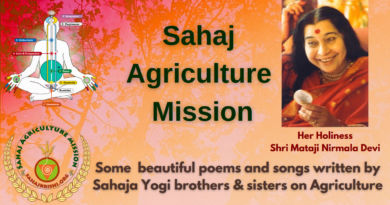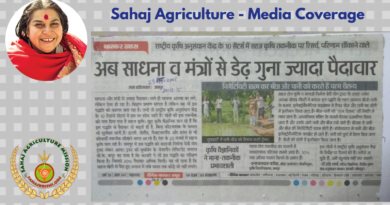National Seminars on Sahaja Agriculture
National Seminars on Sahaj Agriculture
Organised 5 National level seminar/workshop,press conference (473 trainee SC, Agriculture coordinators, progressive sahaja yogis farmers), Exhibition and presentation on Sahaja Agriculture in every Pujas, presentation at DG,ICAR and 10 Research station, Rahuri Agriculture vidhapeeth, state level seminars/worship, Singhast Kumbha Mela, Sahaja Agriculture picnic/program/krishi Mela/Demo/mass awareness etc.
Proceedings of meeting of National Seminar on Sahaja Agriculture, Jaipur on 12.02.2012
National Seminar on Sahaja Agriculture was organized was organized at Sahaajyoga Centre at Jaipur on 12.02.2012. It was attended over 225 participants from Rajasthan, Maharashtra, Gujurat, HP, Bihar, UK, etc., comprising Sahaja Agriculture experts, scientists and farmers associated with Sahaja Yoga. At this occasion, Sh. G.D. Pareek that about 70% people of India live in the villages. The majority of the farmers are marginal. The inputs to the agriculture are getting expensive and return from modern agriculture to the is going down. He told practicing Sahaja Agriculture would prove very beneficial as there is no expenditure and purely organic. Dr. M. V. Kulkarni, shared his experience on increase of yield upto 14.3-50% in crops like Soyabean, cotton, maize, onion, jawar and bajra etc. in Maharashtra. Sh. Romel Verma told that second green revolution is possible through sahaja agriculture in the country. Experiences and results of National Sahaja Agriculture Project were shared with delegates from other states.
Sh. G.D. Pareek told that theNational Sahaja Agriculture Projectwas designed into two phases, i.e. First phase dealing with implementation of project in whole country and collection of data on experiences of scientists and farmers; second phase dealing with upscaling of the project, while learning from the experiences of the first phase.
The participants like Sh. Jagpal Singh, Dr.R.N. Basu, Col. (Retd.) Partap Singh Khera etc. discussed the aspects of both phases and some useful suggestions were given various participants:
Some useful suggestions:
- Effect of level of spirituality of Sahaj ayogi on agriculture etc. should be studied.
- To give vibrations to tools, machines, tractor, FYM etc. at the time of using them in agriculture.
- To study the effect of Sahaja vibrations on productivity of domestic animals like dairy, poultry, fisheries, pigs etc.
Some participants made querries on issues as below:
- Whether ajwain, Kapoor and Gugle dhuni can be used in place of chemicals for crops affected by diseases and pests.
- Whether vibrated water can be used in place of chemicals for crops affected by diseases and pests.
- Whether vibrated water can be sprayed over the crops with the help of some machines.
- Should we place photograph of Shree Mataji in the agriculture fields.
- Results of trials on vibrated crops in comparison of control crops should be used for extension programmes of Sahaaj Agriculture.
- Vibrations should be used by different methods like placing seeds before photo of Shree Mataji, spraying of vibrated water in the field, vibrating field before and after showing of seeds and before seed maturation in crops etc.
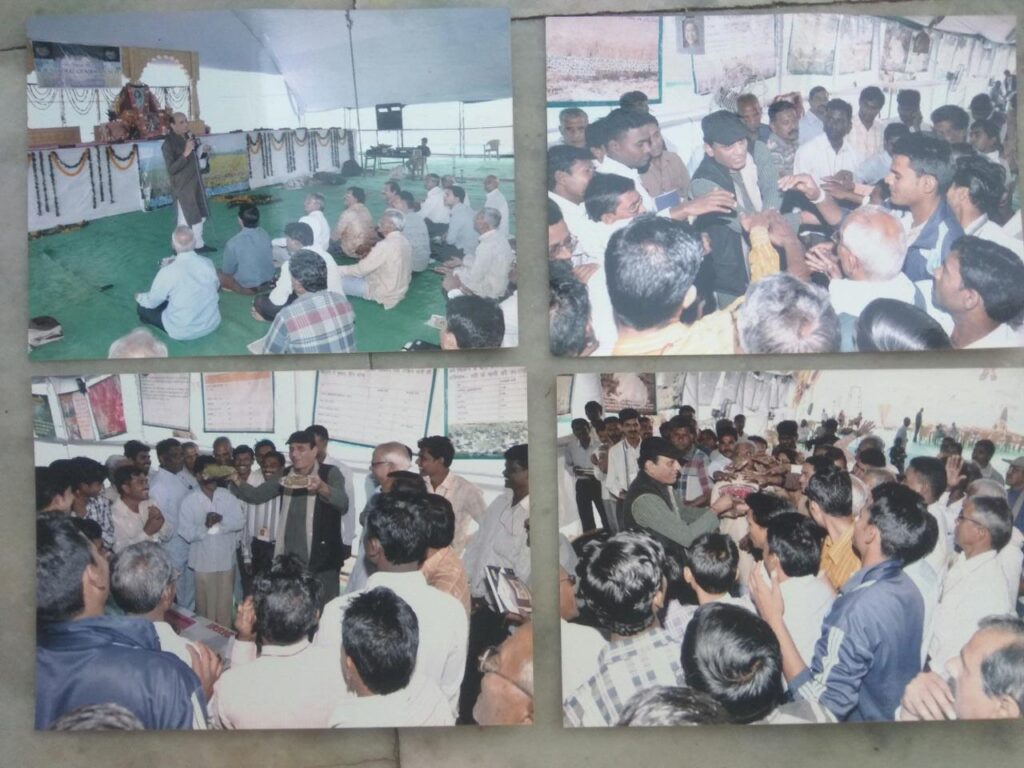
Sh. Jagpal Singh, State Coordinator of Uttarakhand told that there is immediate need to constitute state wise committees for implementation of programmes of Sahaja Agriculture. He shared his experience and told that vibrated fodder given to cow gave 12 kgs of milk as compared to 5 kgs in cow with non-vibrated feed. The yields in vibrated wheat, rice, sugarcane increased significantly as compared to control. The girth of 4 years old vibrated poplar trees was equal to 5-year-old non-vibrated trees.
Sh. Chand Chaudhary, national trustee thanking organizers of the seminar and all participants told that there was a need to organize such seminar in all the states. He also told that there should be International Seminar on sahaja agriculture to promote global development of sahaja Agriculture. He also advised that Sahaaja Agriculture programmes should also be included in national Seminars of Sahajayoga. Directions in this regard should be given to State Coordinators of Sahajayoga and Sahaja Agriculture.
Sh. G.D. Pareek made power point presentation on research findings of Sahaja Agriculture in the country. He informed that a booklet on Sahaja Agriculture has been prepared and distributed in the country. The programmes need to extend to other allied field of Agriculture like animal husbandry, Fisheries and vermicompst etc. He gave following suggestions:
- Constitution of Sahaja Agriculture Committees at State, District and Block levels in each state.
- Launching of nationwide “Sahaja Agriculture Awareness Rath Yatra” in the country learning from the experience of “Sahajayoga Rath Yatra”.
- Preparation and distribution of Sahaja Agriculture literature, booklet, posters and pamphlets in simple local languages and Launching of Sahaja Agriculture programmes at state, district, block and village Panchayat levels.
- Distribution of Sahaja Agriculture literature and booklet etc. to policy makers, officials of Ministry of Agriculture and ICAR, officials and scientists of Agricultural, Horticulture and Forestry universities and their research Stations and Krishi Vigyan Kendra, officials of State departments of Agriculture, Horticulture and Forest, NGOs.
- Distribution of pamphlets and information on Sahaja Agriculture to above agencies through email and whatsapps etc.
- To organize the workshop/seminars on Sahaja Agriculture at state and district levels before start of the kharif and rabi seasons (Pre seasonal Sahaja Agriculture seminars/Workshops).
- To identify the serious agricultural issues in each state and prepare the Work plan to carry out research to address those issues.
- To organize Farmers Field Days on Sahaja Agriculture to address the issues of the farmers.
Dr. S.P. Singh, Botanist, Saharanpur gave following suggestions on Sahaja Agriculture:
- Soil testing should be done at university/institute/state govt labs.
- Seeds and biofertilizers should be vibrated before sowing in the fields.
Sh. J.D. Kaushal, Saharanpur
- To communicate the results of research already done by ICAR with a request to state Agricultural universities/ICAR institutes to start local experiments and extension activities under the guidance of Sahaja Agriculture Experts.
- Agricultural universities/ICAR institutes to organize the Sahaja Agriculture programmes/exhibitions during their Agricultural workshops/melas for the farmers.
- To organize the Sahaja Agriculture programmes/exhibitions at district and block levels in collaboration with Agriculture/Horticultural officials.
Sh. T.S. Baba, Hyderabad gave following suggestions:
- Making a documentary film on Sahaja Agriculture after collecting all inputs on research and training and experiences of farmers.
- To get the Sahaja Agriculture included in the syllabus of schools, colleges and universities.
- To start the Toll free service on Sahaja Agriculture.
- To establish Printing press on Sahaja Agriculture at National level.
Sh. Kuldeep Mehta, Chopal, HP told that apple is an important crop of HP and Special workshop should be organize to issues (e.g. yield and diseases) of the growers of apples.
Sh. Amar Singh Chaudhary, Jaipur told that vibrations should be used for preparation of vermicompost for organic agriculture.
Sh. Shrivastav, Agriculture Engineer, Jaipur, told that research at some suitable university should be done on biochemical and physiological changes in plants of various crops.
One Sahajyogi told some especial trial should be held to study effects of vibration on bee farming at some research organization.
One Sahajayogi advised to invite the non-sahajayogi Veterinary doctors, horticulture, Forestry and bees experts.
One Sahajyogini told that Shree Mataji had advised not to use hybrid varieties for Sahaja Agriculture.
At the end of the Seminar, Sh. Chand Chaudhary, organizer of this seminar told that we should adopt practical approach dealing with government officials and farmers, as they are not aware of the importance of Sahaja agriculture and educate them with patience. The success of the programmes will depend on the dedication, hard work and use of modern technologies and development of rapport with farmers and various stake holders. He told that production and use of vibrated agriculture produce will also be of better-quality food with divine vibrations, giving us better health and peace, besides bring prosperity to the farmers. He told that Shree Sakumbri Devi has an important role in the enhancement of agriculture production as she came on the earth to bless the farmers of the country, as Shree Mataji, had told in her speech during Gudi Padwa pooja on 5th April 2000 at Noida. He also informed that Sahaj Agriculture would be initially practiced in 15 bigha of land near Jaipur. He thanked all the team members for organizing this highly successful Sahaja agriculture seminar and participants for attending the seminar at Jaipur.
Proceedings of meeting of Sahaja Agriculture held during the International Birth Day pooja, 19th-20th March 2012, Chindwara, MP
Lt. General Sh. V.K. Kapoor, while addressing the participants, to prepare the Work Plan on Sahaja Agriculture.
Sh. Dinesh Rao, National Trustee told that National trust would have to promote Sahaja Agriculture Project. He also told after research trials on Sahaja Agriculture at University level, the recommendations will be approved by ICAR for Sahaja Agriculture.
Sh. Chand Chaudhary, National trustee and Incharge of Sahaja Agriculture Project told that there was a need to take the training and Extension Programmes to the village.
Dr. M.V. Kulkarni, National trustee gave information on the progress of work of Sahaja Agriculture Project on Kahrif season of 2012. He also advised to prepare a Work Plan of Sahaja Agriculture Project by taking inputs from State and district Coordinators of Sahaj Agriculture.
The State Coordinators, who attended the meeting assured for the cooperation in the preparation of work Plan on Sahaja Agriculture.
Sh. G.D. Pareek, Member of National Sahaj Agriculture Project, made a presentation of 62 slides on progress of work done on Sahaja Agriculture at National level. He informed that Shree Mataji had given suggestions for using vibrations for improving Sahaja Agriculture in her speeches during public programmes at Lucknow in 1986, Mumbai on 26.12.75 (Cassette on Parmatma Key Prem Kaa Anubhav Vigyan Sey Agey, CD on Sankranti Avam Surya Dev Kaa Mahatav, 14.12.96, Gudipadwa pooja on 6.4.2000 at Noida.
The organizer the meeting of Sahaja Agriculture thanked for the participation of the Sahaj Agriculture delegates.
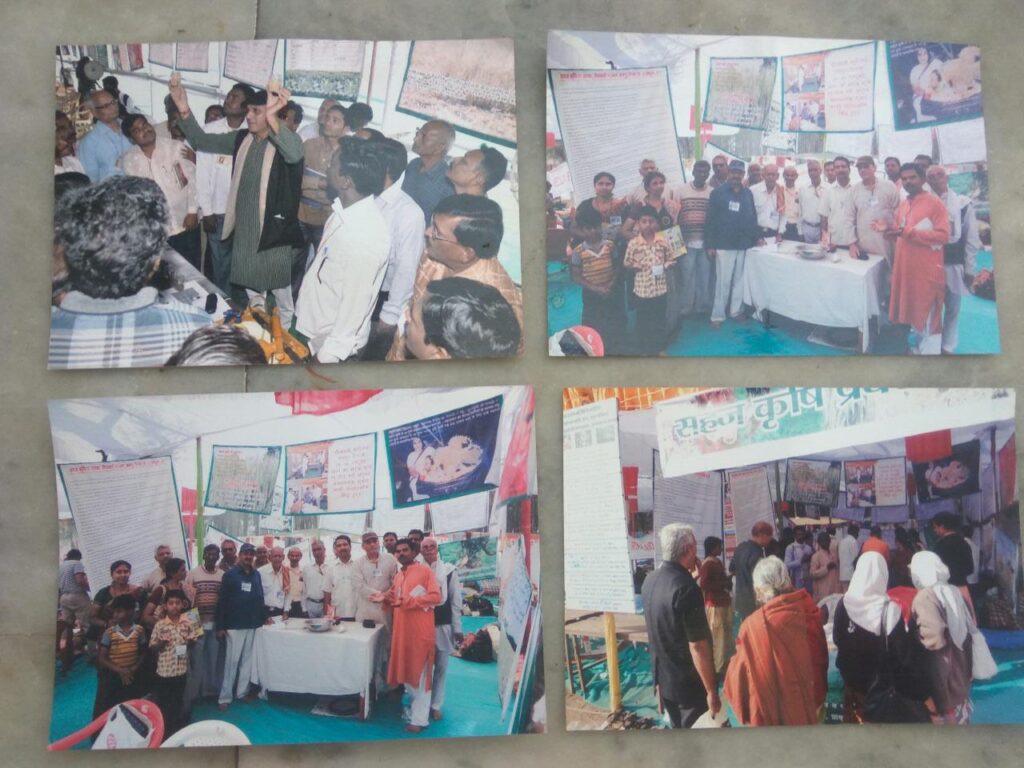
Proceedings of meeting of Meeting of Sahaja Agriculture held during the National Sajaja Yoga Seminar, 7-10th June 2012, Renuka Jheel, HP
Sh. Romel Verma, Sh. D.C. Rao, Sh. Chand Chaudhary, Sh. Jagpal Singh, Sh. Deepak Verma, Dr. Rajesh, Dr. Sh. Simple, Sh. Sunil Sharma, Sh. Natraj, and National Trustees and State and district Coordinators and other Sahaj Agriculturists and Sahajyogi visited the exhibition on Sahaja Agriculture. At this occasion, several farmers shared their experiences on effect of vibrations on production of agriculture. Some of these farmers informed the results as below:
Sh. Krishna Pal Singh, Village Firshal, Baghpat told that wheat production increased to 27.5 quintals/acre in vibrated field as compared to 19.5 quintals in non-vibrated field. (Tel: 82736272990).
Sh. M.N. Shrivastav, 3A, Utica, Sonmiti, Bareli, UP (9319481833) produced wheat on marginal land, which produced 3 times more yield in wheat crops than the control crop.
Mrs. Asha Gupta, Delhi (9013067935) observed tremendous increase in the number and size of vibrated rose flowers as compared to control.
Sh. Atma Ram Mishra, 95/A New Basti, Hardoi, UP (9897165467) produced more yield in in vibrated pea crop than un-vibrated field.
Sh. M. J. Tamway, Agriculture Officer, Shrirampur, Maharashtra (9422728385) obtained 100% germination in the vibrated seeds of French bean crop.
Proceedings of meeting of National Seminar on Sahaja Agriculture, at Jaipur on 14-15th November 2012
National Seminar on Sahaja Agriculture was organized was organized at Shree Bhavani Niketan Parishar, Sikar Road in Jaipur on 14-15th November 2012. It was attended by national trustees, state coordinators and participants from Maharashtra, Rajasthan, Gujurat, HP, Bihar, UK, UP, HP etc., comprising Sahaja Agriculture experts, scientists and farmers of 14 states.
On 14th November 2012
Sh. Chand Chaudhary, President of Sahajayoga Awareness and Expansion Committee, inaugurated the 2 days National Seminar on Sahaja Agriculture and Col. R.V. Singh, Coordinator, Rajasthan welcome the participants of the seminar.
Sh. G.D. Pareek, Member Secretary, National Sahaja Agriculture Project Committee highlighted the achievements on awareness creation, literature and field visits and training programmes of the Sahaja Agriculture Project.
Dr.M.V. Kulkarni, National Trustee, shared his experience on Sahaja Agriculture in Maharashtra and some other states.
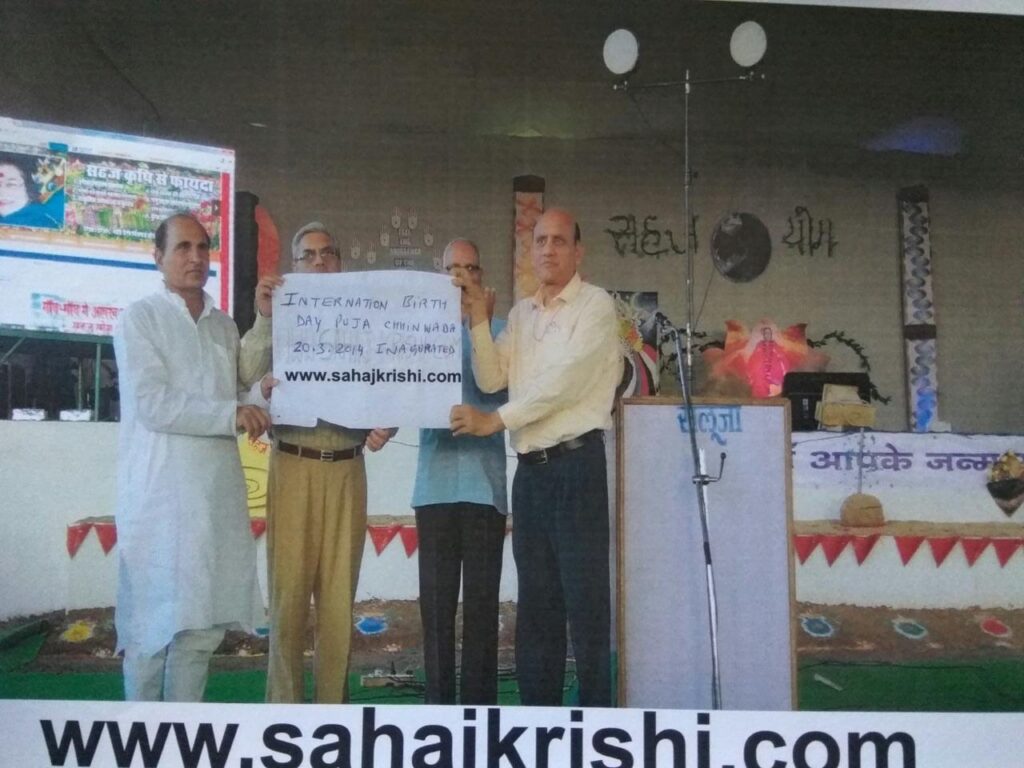
Several participants of 14 states shared their very encouraging results of Sahaja Agriculture:
Sh. C. Mohan, Kerala told that there was tremendous improvement in yields of mango, amwla, kazu and anaar due to adopting techniques of Sahaja agriculture.
Sh. Naji Kuchankar, Maharashtra stated that wild pigs could not enter his fields of maize, wheat and gram, when the vibrated seeds were sown in the fields. He informed that there was 13-13.5 quintals/acre of cotton production as compared to the 8-9 quintals/acre in the control.
Sh. Ravinder Jaware, Amrawati, Maharashtra reported better yields in onion and chukander crops as compared to the control.
Sh. Babu Ram, Hardoi, UP reported 20 quintals rice/bigah in vibrated field as compared to 14-15 quintals rice/bigah in non-vibrated field. There was no attack of any diseases, which were observed in other adjacent fields.
Sh. Ashish Raot, Yavatmai, Maharashtra informed that there was production of 6 quintals of soyabean per acre in vibrated field than 3.5 quintals in control field.
Prof. V. K. Mohanti, Agricultural Univesrity, Udisa told that there was higher yield in crops like mango, rice and anaar with better quality of fruits/seeds than the control crops.
Sh. Aashish Joshi, Amravati, Maharashtra informed the improvement of health of wounded cow which gave birth to healthy calf.
Sh. Bahadurmal Saini, Khedi, Rajasthan told that there was 25-30% increase in vibrated wheat crop than the control. The cows given vibrated forage produced higher milk as compared to control.
Sh. H.P.Chaudhary, Faridabad reported 15-20% higher yield in vibrated wheat crop than the control crop.
Sh. Hardas Kukurdey, Vardha, Maharashtra informed that he was spreading awareness about Sahaja Agriculture in 26 villages since 2006. Mrs. Sakshi Mohanti, Orrisa told that farmers engaged in Sahaja Agriculture should daily meditate and visit sahaaj Yoga Centre and attain deep state of meditation, which had better effect on agriculture. Sh. I.P. Sarashwat, State Coordinator, UP told that 150 farmers have been trained in Sahaja Agriculture.
It was suggested that State Sahajayoga Coordinators should appoint State Sahaja Agriculture Coordinator in each state.
On 15th November 2012
- Sh. G.D. Pareek displayed the 45 Posters on Sahaja Agriculture. There were demonstrations of effect of vibration on the germination and growth of seedlings of what, barley, gram and sarso in comparison of their controls. He also assured to participants to guide and help them in adopting Sahaaj agriculture.
- Kits with literature on sahaja agriculture were provided to the sahajayogi working in spreading sahaaj Agriculture in the country.
- The vibrated Seeds of wheat, gram, barley and sarso were given to the farmers.
- The Participants were taken to the crop fields and trained with techniques of sahaja Agriculture.
- At the end of seminar, Shreechand Chaudhary, President, National Parchar avam parshar and National trustee thanked the organizing team and participants of the seminar. Dr. M.V. Kulkarni also gave certificates and sari to women participants. The seminar ended with meditation and thanks to Shree Mataji, Adiskhti for her blessings.
Following decisions were taken for work Plan for 2013 in the seminar:
Work Plan-I:
- Committee of National Sahaaj Agriculture Project will analyses the research findings of sahaja Agriculture in the following states:
1.Maharashtra (Uvatmal, Amravati, Nashik districts), 2. MP, 3.Rajasthan (Udaipur, Nagor, Kota), 4. UP, 5. Bihar, 6.Kerela, 7.AP, 8. Gujarat 9. UK 10. Haryana 11. Orrisa 12. J&K 13. HP and 14. Nepal.
- To spread Sahaja Krishi in all 33 states.
- Three districts in each state will be selected.
- Sahaja agriculture Expansion in 10-12 tehshils and 300-400 villages.
- Awareness creation in 35-40 tehshils
- 400 teams of experts in each state.
- There will be 3-4 members in each team.
- The participants of this Seminar will guide the teams in each states.
- The National Trustees and State Coordinators will constitute above teams and implement the programmes in above 14 states.
- The above programme will be started in January 2013 and training programmes of 400 teams would be completed by May 2013.
- By May and June, all the teams will go to respective villages and train the farmers and help them in vibrating and sowing the seeds in the fields of farmers.
- These teams had to go the villages and with the help of village Pradhan, give self realization to interested farmers and train them in meditation and complete this work during January-May 2013.
- After above preparations, Sahaja Agriculture Project will be implemented in June 2013 (Kharif season) in 3500-4000 villages of India.
- The information on above implementation of programmes have to be collected along with photos and analyzed.
- All National Trustees and State Coordinators will send all above information to Sh. G.D. Pareek at gdpareek@yahoo.com, Tel: 9828451514) for compilation.
Action Plan-II
- On the basis of experiences on above villages, Sahaja Agriculture Fairs will be organized in each state.
- These Sahaja Agriculture Fairs will be organized in those districts, where no no work on Sahaja Agriculture has been done.
- The farmers who have benefited from their experiences on Sahaja Agriculture will be invited and share their experiences with the farmers in these fairs and also work to expand Sahaja Agriculture in more districts of their state.
- The above work will be completed during November 2013 to January 2014.
Annual Report of 2014-15, National Trust
Report on Sahaj Krishi Programme:
By the grace of our Divine Mother, the way of Sahaj Krishi was opened for prachar and prasar of Sahaja yoga, particularly in the rural India. Through HER Divine Planning, H.H. Shri Mataji guided us to start programme on Sahaj Krishi on large scale w.e.f. 2011-12.
Initial Work:
Initially this programme was limited to a few states viz. Maharashtra, Rajasthan, Uttar Pradesh etc being done sporadically by a few Sahaj Yogi Farmers.
Workshops and Meetings:
When reports from different corners started receiving and indicating Shri Mataji’s Divine power giving positive responses in increasing Agricultural production, a decision at National Trust level was taken to hold All India workshops and meetings on this subject.
Accordingly, the first National Level seminar on Sahaj Krishi was held at Jaipur (Rajasthan) in February 2012. Thereafter, on various occasions almost every year such meetings / workshops were held and Sahaj yogis were guided and motivated to undertake Sahaj Krishi work so that through it Sahaj Yoga propagation could take place.
Status up to 2014-15:
Again, due to H.H. Shri Mataji’s blessings and collective work, this message spread very fast amongst the Sahaj Yogi and Non Sahaj Yogi farmers spread over different states in India. Hence, a National Level Sahaj Agriculture Committee was formed involving interested and active Sahaj Yogis from various states.
Guidance and proper counselling was done at regular interval and up to the year 2014-15, the Sahaj Krishi work which was limited to a few states had spread in 20 states in India. Through collective efforts we could estimate that in the last 4 years almost 3 to 4 Lakhs farmers throughout India received the message of Sahaj Krishi and nearly 1 Lakh farmers had started adopting Sahaj Krishi and achieving its benefits.
Breakthrough:
The Divine Mother led us to a breakthrough, when our Vice Chairman of the National Trust explained the entire work to officials and scientists of Krishi Bhavan, New Delhi in April – May 2015. Impressed by the whole work and approach helping the common farmers, the Ministry of Agriculture, New Delhi arranged a joint meeting of Sahaj Yoga team and officials and scientists of Krishi Bhavan / ICAR on 20th May 2015, where a decision was taken to undertake Sahaj Krishi experimental work on 10 selected National Research Centres (NRCs) of the ICAR.
Proceedings of All India Sahaj Krishi Workshop, Chindawada (MP), 21st -22nd March 2015
All India Sahaj Krishi Workshop for all Sahaj yogis/yoginis actively engaged in this programme was conducted at Chindawada (MP) during the
Birthday Puja of H.H. Shri Mataji Nirmala Devi. The programme was organized in two parts, on 21st Macrh evening and on 22nd March ’15. In all, 192
participants (Ladies and Gents) representing 15 states of India took part in the workshop.
The National Trustees, Mr. Dinesh Rai (Vice Chairman), Mr. B. N. Tiwari,Col. B. J. Mankotia, Mr. Shrichand Chaudhari (I/c Prachar Prasar) along
with Dr. M. B. Kulkarni took active part in the discussions and decision making.
The following issues were discussed and decisions taken:
On the evening of 21st March general feedback from all the participating farmers was obtained. An overall consensus was that by the blessings of H.H. Shri Mataji, every farmer doing Sahaj Krishi has been getting unbelievable positive and encouraging results. Some farmers actually brought crop samples to show the difference between vibrated and non-vibrated crops. It was suggested that in every seminar (National Level) topic on Sahaj Krishi must be included with at least 1 – 2 Hrs of deliberations.
On 22nd March morning 7 am all of them assembled in the Puja pendal. Mr. G. D. Pareek, Mr. Nagaraju and Mr. Mohanti demonstrated all essential and required aspects of Sahaj Krishi – including prachar – prasar in villages. Dr. M.B. Kulkarni briefly explained the action plan for all for the year 2015-16 and also future research on some important aspects. After prolonged discussions, the following decisions were taken:
Every participant will demonstrate to his/her neighboring farmers benefits of Sahaj Krishi, motivate them, give them self realization and will bring at least 5 new farmers to Sahaja yoga collectively during 2015..16
Dr. M. B. Kulkarni, Mr. G. D. Pareek, Mr. Nagaraju and Mr. Mohanti will adopt one village each in their respective states and will convert that entire village farming community into Sahaj yogis, encourage them to do Sahaj Krishi and will turn that village into “Sahaj Krishi Gram” in the year 2015-16. (Action All concerned)
In order to meet emergency expenses, printing expenses (Krishi literature/pamphlets etc) a token budget/financial provision be made to
each state so as to boost up this programme. Details will be worked out and proposal will be submitted to the National Trust. (Action- Dr. M. B.
Kulkarni)
So far, data collection, gathering feedback information has been unsatisfactory. Hence, a mechanism to streamline this aspect was developed.
Every farmer will be sent a printed reply paid post card to get needed data (brief). The farmer has to fill up information in that card and send it back to Mr. G. D. Pareek. (Action-Mr. G. D. Pareek)
Dr. M. B. Kulkarni proposed an experiment to deal with the climatic changes that harm crop production of farmers bringing heavy economic losses. He proposed to create a “Simulation Model” (most probably at the Pratishthan, Pune) to study this aspect. It was expressed that by the blessings of H.H. Shri Mataji, this would provide a divine solution for farmers.
Mr. G. D. Pareek will prepare a detailed note (Paper) on Sahaj Krishi (On the lines given to him) for discussion and presentation to the Secretary, Agriculture – Govt of India. This is as per the suggestion of Mr. Dinesh Rai (VC)
Such workshops will be organized zone wise (Action – Mr. Shrichand Chaudhari)
The meeting was concluded with a prayer of gratitude to our Divine Mother, to all participants and National Trustees.
Proceedings of Sahaja Agriculture Workshop of 21-22 March 2015 at Chchinwada MP
Sh D.C. Rai, Vice-Chairman of National Trust stated progress of Sahaja Agriculture. He told that to achieve 5 to 10 % growth of agriculture in India can be achieved through Sahaja Agriculture. Project.
1 Shrichand Chowdhary, Chairman, NSAP advised to organize Sahaja Agriculture Workshop in 5 Zones of India annualy.
2 Feedback and progress of Sahaja Agriculture Project was presented for Sonipat (Haryana), Kotputali (Rajasthan), Hyderbad, Guntur (Telangana), Orissa, Naded, Nasik, Pune (Maharashtra), Gwalior (MP), West Bengal, have shown benefits of using Sahaja Agriculture techaniques, which are low cost, pollution free and increase in yield 10-15% even more.
3.Sh. Nagaraju, Hyderabad stated that there is no effect of yellow mosaic in Urd crop upto 55 days as per experiment conducted at ICAR project at LAM, Farm Guntur .
4. In last Dr. M.B. Kulkarni, National Trustee stated that every state should adopt 500 villages under Sahaja Agriculture Project, subject to provision of budget by National Trust of Sahajayoga, New Delhi.


